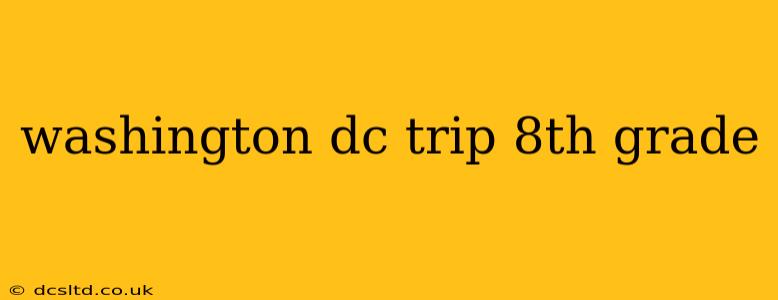Washington, D.C., the nation's capital, offers an unparalleled educational experience for 8th graders. A trip to D.C. transforms history lessons from textbooks into tangible realities, fostering a deeper understanding of American government, culture, and history. This guide will help you plan an enriching and memorable trip for your students.
Planning Your 8th-Grade Washington D.C. Trip
Before embarking on your adventure, careful planning is crucial. This includes budgeting, transportation, accommodation, and itinerary development. Consider these key aspects:
-
Budgeting: Costs can vary significantly depending on group size, transportation methods (bus, train, plane), accommodation choices (hotels, hostels), and planned activities. Secure funding through school initiatives, fundraising activities, or parental contributions. A detailed budget breakdown, including potential contingencies, is essential.
-
Transportation: Transportation to and around D.C. needs careful consideration. Bus trips are cost-effective for larger groups, while flights offer speed and convenience but can be more expensive. Within the city, consider using the efficient public transportation system (Metro) or arranging for guided bus tours.
-
Accommodation: Secure appropriate accommodation well in advance, especially during peak seasons. Consider proximity to major attractions and the availability of amenities suitable for a student group.
-
Itinerary: Develop a well-structured itinerary balancing educational visits with fun activities. Include buffer time to accommodate unexpected delays. Prioritize key sites and attractions based on curriculum alignment and student interests.
Must-See Monuments and Museums for 8th Graders
Washington D.C. boasts a wealth of historical sites and museums, offering something for every interest. Here are some must-sees for an 8th-grade class:
-
National Mall: The heart of D.C., the National Mall is home to iconic monuments like the Lincoln Memorial, Washington Monument, and World War II Memorial. These monuments provide powerful visual representations of American history and ideals.
-
Smithsonian National Museum of Natural History: This museum offers fascinating exhibits on dinosaurs, gems, and various aspects of the natural world, sparking curiosity and engaging diverse learning styles.
-
National Air and Space Museum: A captivating experience for students interested in science and technology, this museum showcases the history of flight and space exploration, featuring iconic aircraft and spacecraft.
-
National Museum of American History: This museum traces the development of American culture and technology, displaying artifacts ranging from presidential gowns to early computers, offering tangible connections to history lessons.
-
United States Capitol Building: Witnessing the heart of American democracy is an invaluable experience. Consider a guided tour to understand the legislative process and the building's significance.
What Activities Are Best for 8th Graders in Washington D.C.?
Beyond the museums and monuments, incorporating interactive and engaging activities can enhance the learning experience. Consider these options:
-
Interactive Exhibits: Many museums feature interactive exhibits allowing students to actively participate in the learning process, fostering deeper engagement and understanding.
-
Guided Tours: Professional guides can provide valuable context and insights into the historical significance of various sites, enriching the learning experience.
-
Student-Led Projects: Assign students pre-trip research tasks focused on specific monuments or museums, encouraging independent learning and presentation skills.
What are some Educational Activities in Washington D.C.?
Washington D.C. offers numerous opportunities beyond sightseeing for educational enrichment:
-
National Archives Museum: View the Declaration of Independence, the Constitution, and the Bill of Rights – foundational documents of American democracy.
-
International Spy Museum: Explore the world of espionage through interactive exhibits, offering a unique and engaging learning experience.
-
Ford's Theatre: Learn about the assassination of President Lincoln and the history of this iconic theater.
-
Newseum (now closed): While the Newseum is sadly closed, its digital archives and the lessons it offered on media literacy still provide valuable resources for educators. Consider incorporating alternative media literacy programs as a replacement.
How Much Does a Washington D.C. Trip Cost for 8th Graders?
The cost of a Washington D.C. trip for 8th graders varies widely depending on several factors:
-
Transportation: Flights are typically more expensive than bus travel.
-
Accommodation: Hotel costs vary based on location and amenities.
-
Activities and Entrance Fees: Budget for museum entrance fees and other activities.
-
Meals: Plan for meals, considering packing lunches to reduce costs.
-
Souvenirs: Allocate a small amount for students to purchase souvenirs.
A detailed budget breakdown is essential before finalizing plans. Contact various tour operators or transportation providers for quotes.
How Long Should an 8th-Grade Trip to Washington D.C. Be?
The ideal duration depends on your objectives and budget. A 3-4 day trip provides sufficient time to cover major landmarks and museums, allowing for a balanced itinerary without feeling rushed. Shorter trips may necessitate prioritization, while longer trips allow for greater depth and exploration.
This comprehensive guide provides a solid foundation for planning an unforgettable and educational Washington D.C. trip for your 8th-grade students. Remember to adapt the itinerary based on your students' interests and educational goals. The city's rich history and vibrant culture offer a unique and invaluable learning experience.
